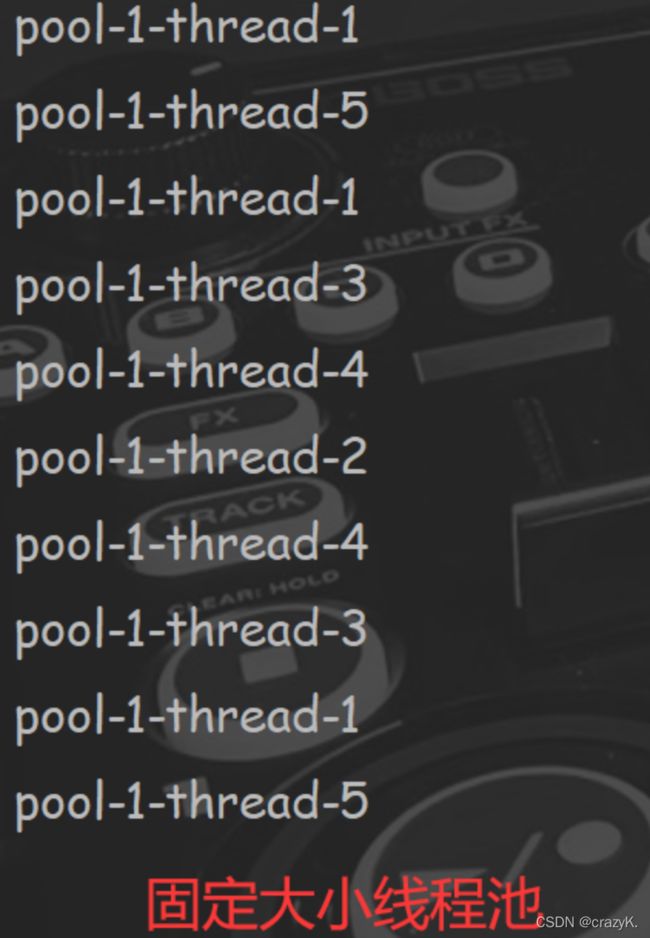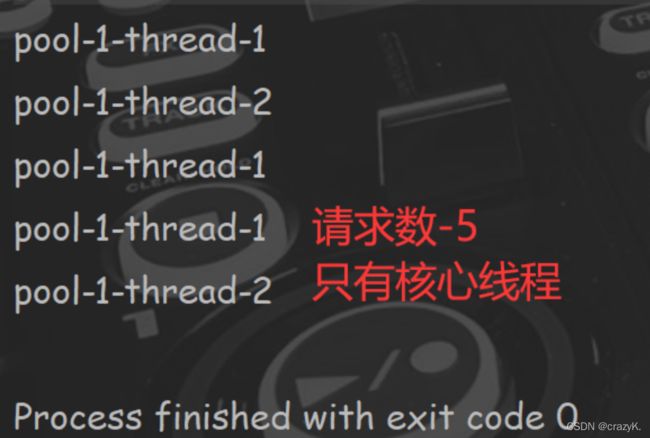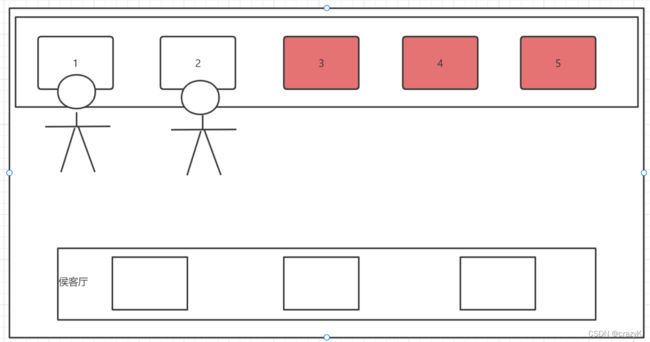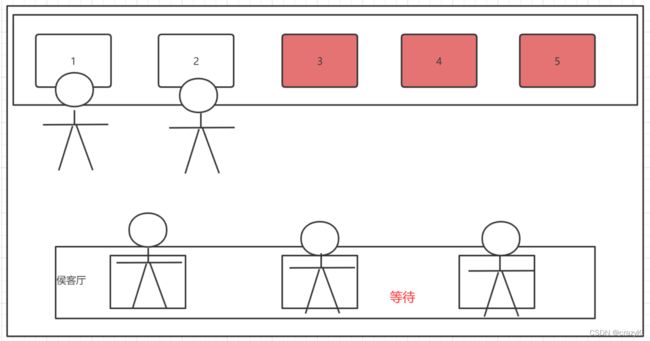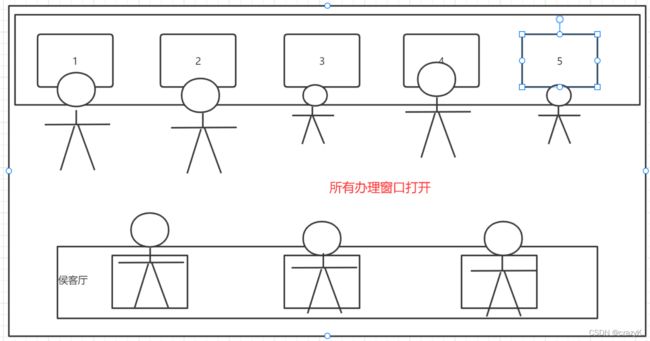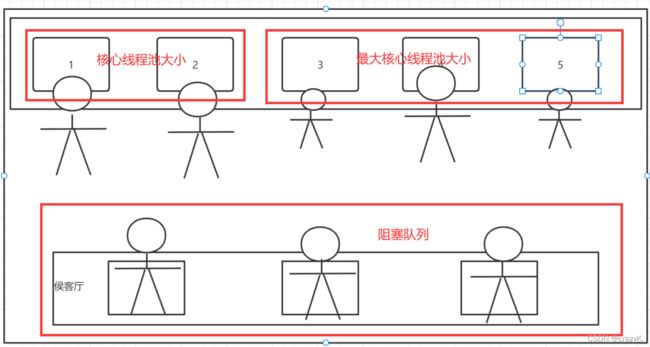线程池(通俗易懂)
目录
一、什么是线程池
二、创建线程池的方式
三、线程池的七大参数
四、四种拒绝策略
1.AbortPolicy()
2.CallerRunsPolicy()
3.DiscardPolicy()
4.DiscardOldestPolicy()
五、自定义一个线程池
1.场景描述
2.代码实现
一、什么是线程池
线程池其实就是一种多线程处理形式,处理过程中可以将任务添加到队列中,然后在创建线程后自动启动这些任务。这里的线程就是我们前面学过的线程,这里的任务就是我们前面学过的实现了Runnable或Callable接口的实例对象。
线程池的优点:降低资源消耗、提高响应速度、方便管理;线程可以复用、可以控制最大并发数、可以管理线程
二、创建线程池的方式
| 方式 | 描述 |
| Executors.newSingleThreadExecutor(); | 创建一个单一的线程池 |
| Executors.newFixedThreadPool(int nThreads); | 创建一个固定大小的线程池,参数填线程池大小 |
| Executors.newCachedThreadPool(); | 创建一个可伸缩的线程池,遇强则强,遇弱则弱 |
public class ThreadPoolTest {
public static void main(String[] args) {
ExecutorService threadPool = Executors.newSingleThreadExecutor();
//ExecutorService threadPool = Executors.newFixedThreadPool(5);
//ExecutorService threadPool = Executors.newCachedThreadPool();
try {
for (int i = 1; i <= 10; i++) {
//在execute中丢入一个Runnable ---> lambda 表达式
threadPool.execute(()->{
System.out.println(Thread.currentThread().getName());
});
}
} catch (Exception e) {
e.printStackTrace();
} finally {
//使用完毕后,程序结束,关闭线程池
threadPool.shutdown();
}
}
}三、线程池的七大参数
| 参数 | 描述 |
| int corePoolSize | 核心线程池大小 |
| int maximumPoolSize | 最核心大线程池大小 |
| long keepAliveTime | 超时时间 没有人使用会自动释放 |
| TimeUnit unit | 超时单位 |
| BlockingQueue |
阻塞队列 |
| ThreadFactory threadFactory | 线程工厂,创建线程的,一般不用动 |
| RejectedExecutionHandler handler | 拒绝策略 |
在上面线程池的三种创建方式种中,点进源码,可以看到它们都new 了一个 ThreadPoolExecutor
//newSingleThreadExecutor
public static ExecutorService newSingleThreadExecutor() {
return new FinalizableDelegatedExecutorService
(new ThreadPoolExecutor(1, 1, //核心线程,最大线程为 1
0L, TimeUnit.MILLISECONDS,
new LinkedBlockingQueue()));
}
//newFixedThreadPool
public static ExecutorService newFixedThreadPool(int nThreads) {
return new ThreadPoolExecutor(nThreads, nThreads, //核心线程,最大线程为传进来的参数
0L, TimeUnit.MILLISECONDS,
new LinkedBlockingQueue());
}
//newCachedThreadPool
public static ExecutorService newCachedThreadPool() {
return new ThreadPoolExecutor(0, Integer.MAX_VALUE,//核心线程默认是0,最大线程为21亿
60L, TimeUnit.SECONDS,
new SynchronousQueue());
} ThreadPoolExecutor 中就包含了线程池的七大参数
// ThreadPoolExecutor
public ThreadPoolExecutor(int corePoolSize, //核心线程池大小
int maximumPoolSize, //最核心大线程池大小
long keepAliveTime, //超时时间 没有人使用会自动释放
TimeUnit unit, // 超时单位
BlockingQueue workQueue, // 阻塞队列
ThreadFactory threadFactory, // 线程工厂,创建线程的,一般不用动
RejectedExecutionHandler handler// 拒绝策略
) {
if (corePoolSize < 0 ||
maximumPoolSize <= 0 ||
maximumPoolSize < corePoolSize ||
keepAliveTime < 0)
throw new IllegalArgumentException();
if (workQueue == null || threadFactory == null || handler == null)
throw new NullPointerException();
this.acc = System.getSecurityManager() == null ?
null :
AccessController.getContext();
this.corePoolSize = corePoolSize;
this.maximumPoolSize = maximumPoolSize;
this.workQueue = workQueue;
this.keepAliveTime = unit.toNanos(keepAliveTime);
this.threadFactory = threadFactory;
this.handler = handler;
} 四、四种拒绝策略
| 拒绝策略 | 描述 |
| new ThreadPoolExecutor.AbortPolicy() | 线程池默认拒绝策略,如果元素添加到线程池失败,会抛出RejectedExecutionException异常 |
| new ThreadPoolExecutor.CallerRunsPolicy() | 如果添加失败,那么主线程会自己调用执行器中的execute方法来执行任务 |
| new ThreadPoolExecutor.DiscardPolicy() | 如果添加失败,则放弃,不会抛出异常 |
| new ThreadPoolExecutor.DiscardOldestPolicy() | 如果添加到线程池失败,会将队列中最早添加的元素移除,再尝试添加,如果失败则按该策略不断重试 |
场景见下面的自定义线程池:核心线程数-2;最大核心线程数 - 5;阻塞队列 - 3 可容纳最大请求数 - 8
1.AbortPolicy()
分别将请求数设置为5,8,9
2.CallerRunsPolicy()
将请求数量设置为9,不超过最大容量的情况都相同
3.DiscardPolicy()
将请求数量设置为9,不超过最大容量的情况都相同
4.DiscardOldestPolicy()
将请求数量设置为9,不超过最大容量的情况都相同
新请求把旧请求顶替
五、自定义一个线程池
1.场景描述
银行办理业务
平时银行只开放两个办理业务窗口,当两个窗口都有人时,新来的客户会进入侯客厅等待,当人过多时3,4,5窗口会打开进行业务办理
2.代码实现
public class ManualPool {
public static void main(String[] args) {
ExecutorService threadPool = new ThreadPoolExecutor(
2, //核心线程池大小
5, //最大核心线程池大小
3, //超时时间
TimeUnit.SECONDS, //超时单位
new LinkedBlockingQueue<>(3), //阻塞队列 --> 相当于银行的候客区
Executors.defaultThreadFactory(), //线程工厂
new ThreadPoolExecutor.DiscardOldestPolicy() //拒绝策略
);
try {
//最大容量 = 阻塞队列大小 + 最大核心线程池大小
for (int i = 1; i <= 9; i++) {
//在execute中丢入一个Runnable ---> lambda 表达式
//使用线程池来创建线程
threadPool.execute(()->{
System.out.println(Thread.currentThread().getName());
});
}
} catch (Exception e) {
e.printStackTrace();
} finally {
//使用完毕后,程序结束,关闭线程池
threadPool.shutdown();
}
}
}

